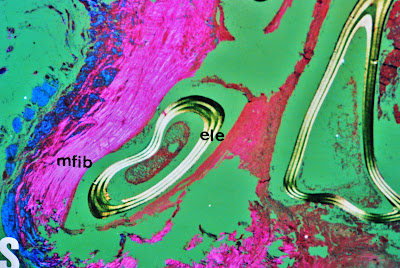15.-ATRIAL TUMOR AND SUDDEN UNEXPECTED DEATH.
Prof. Garfia.A
A fithty year old man in good health, suffered an acute heart failure secondary to obstruction of blood flow, and was pronounced dead, at his home. During a legal autopsy a heart weighing 540 g was found, which showed biventricular hypertrophy (RV: 0.8 cm; LV 2.0 cm); the left heart was moderately dilated.
At the left atrium was detected a polipoid tumor, 6 cm diameter in its biggest dimension, which was attached, on a broad base, to the atrial septum (fossa ovalis). The tumor had a villous appearance and presented gelatinous areas intercalated with haemorrhagic areas.The left atrium was almost filled by the tumor which extended down into the mitral valve orifice. The histological appearance of the tumor was very variable in different areas examinated.The bulk of the tumor is made up of a myxoid stroma and embedded in the stroma were the myxoma cells which shows polygonal, spindle or stellate-shaped.The term "lepidic" (scale-like) has been applied to these cells due to their polygonal aspect. In some areas can be seen spaces lined by endothelial cells to which the myxoma cells are loosely attached. Inside the macroscopic haemorrhagic areas the tumor shows numerous vascular spaces of telangiectasis aspect. Also, other elements found in the matrix include haemorrhage foci, old and more recent, located besides the telangiectasis spaces.The differential diagnosis must be made with low-grade sarcomas, so named "myxoid imitators". Sometimes, the distinction between organized thrombus and myxoma, is very difficult. Virtually any cardiac tumor may cause sudden death through a variety of mechanismus including rhythm disturbances, embolization and acute heart failure secondary to obstruction of blood flow. Cardiac myxomas are- generally- tumors found in adults, and present as sudden death in aproximatelly 5% of cases due to embolization to the coronary arteries, acute obstruction of the mitral valve, or also, cerebral embolization
Atrial myxomas are the most common primary benign tumour, show a slight female predominance and are, generally, located in the left atrium. Generally, myxomas are solitary tumors, however, a familial myxoma syndrome has been described: it is called NAME, (acronyms of N: blue naevi; A: Atrial myxoma; M: mucocutaneous myxoma; E: ephelides) or LAMB ( L= lentigines; A= atrial myxoma; M=mucocutaneous myxomas; B blue naevi). In the familial syndrome the tumours can be multiple and located also in a ventricle.
 |
| FORENSICPATHOLOGYFORUM BLOG 15 PROF. GARFIA.A |
 |
| FORENSICPATHOLOGYFORUM BLOG 15 PROF. GARFIA.A |
Photo nº 2.- Gross Pathology:tumoral surface.
The tumoral surface - mamelonne- shows different aspects and colours, from the red-wine, and haemorrhagic aspect, until pearly-white colour. Prof.Garfia.A
 |
| FORENSICPATHOLOGYFORUM BLOG 15 PROF. GARFIA.A |
Shows the hystology of the components of myxoma: free-floating spindle and stellate cells -sometimes syncytial-; myxoid ground substance, and a surface layer.
Prof.Garfia.A
 |
| FORENSICPATHOLOGYFORUM BLOG 15 PROF. GARFIA.A |
Prof.Garfia.A
 |
| FORENSICPATHOLOGYFORUM BLOG 15 PROF. GARFIA.A |
Photo .- 5.- Atrial myxoma.
Some cells show nuclei similar to the Anitschkow cells found in the rheumatic carditis (spindle -shaped cells showing ovoid open vesicular nuclei and condensation of the chromatin toward the nuclear membrane - caterpillar cells). They are considered as a variety of mesenchymall cell readily induced in the connective tissue of the heart, in young individuals, by a wide range of insults. Prof.Garfia.A
Some cells show nuclei similar to the Anitschkow cells found in the rheumatic carditis (spindle -shaped cells showing ovoid open vesicular nuclei and condensation of the chromatin toward the nuclear membrane - caterpillar cells). They are considered as a variety of mesenchymall cell readily induced in the connective tissue of the heart, in young individuals, by a wide range of insults. Prof.Garfia.A


















